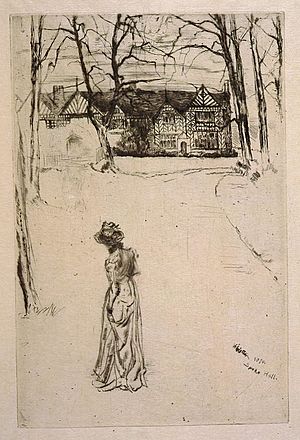Speke Hall facts for kids
Quick facts for kids Speke Hall |
|
|---|---|

North front of Speke Hall
|
|
| Type | Manor House |
| Location | Speke |
| OS grid reference | SJ 41865 82568 |
| Area | Liverpool |
| Built | 1530–1598 |
| Architectural style(s) | Tudor |
| Owner | National Trust |
|
Listed Building – Grade I
|
|
| Official name: Speke Hall | |
| Designated | 28 June 1952 |
| Reference no. | 1359837 |
| Lua error in Module:Location_map at line 420: attempt to index field 'wikibase' (a nil value). | |

Speke Hall is a very old and beautiful house in Speke, Liverpool, England. It's a special kind of house called a manor house. It was built a long time ago during the Tudor period. The house is made with a wooden frame and a mix of mud and sticks called wattle-and-daub. It's one of the best examples of these old houses still standing today. The National Trust, a charity that looks after historic places, now owns Speke Hall. It's also a 'Grade I listed building,' which means it's very important and protected.
Contents
The Story of Speke Hall
The building we see today started being built in 1530. Sir William Norris began its construction. Before this, other buildings stood on the same spot. Some parts of those older buildings are still part of Speke Hall.
How the House Grew
The first part built was the Great Hall in 1530. A year later, in 1531, the Great Parlour wing was added. The North Bay was also built around this time. Between 1540 and 1570, the south wing was changed and made bigger. The west wing was added between 1546 and 1547. The last big change happened in 1598. Edward Norris added the north range then. Since that time, only small changes have been made to the house and its gardens.
Building Materials and Secrets
The house has a strong oak wood frame. This was common for buildings from that time. The wooden frame sits on a base made of red sandstone. A dry moat surrounds the house. The main wooden beams are made stronger with smaller pieces of wood. The spaces between the wood are filled with wattle and daub. This is a mix of woven sticks and mud.
During the Reformation, the Norris family were Roman Catholics. This was a difficult time for Catholics in England. So, the house had secret hiding places. One was a priest hole, where a priest could hide. There was also a special hole in a chimney. This allowed someone to watch the path to the house. They could warn the priest if people were coming. There's also an eavesdrop. This is a small hole under the roof's edge. A servant could listen to conversations of people waiting at the front door.
Later Changes and Owners
In 1612, a porch was added to the Great Parlour. A laundry and a dairy were built in 1860. The laundry was changed again in the 1950s.
The Norris family owned Speke Hall for many years. In 1736, the last Norris family heir, Mary Norris, married Lord Sidney Beauclerk. After Mary died in 1766, the house was rented out. In 1795, a merchant from Liverpool named Richard Watt bought the house. The last person from the Watt family to own it was Miss Adelaide Watt. She inherited the house in 1878 when she was 21.
Miss Watt died in 1921. She left the house to be looked after for 21 years. During this time, staff cared for it. In 1943, the house became owned by the National Trust. From 1946 to 1974, Liverpool City Corporation managed the house. Then, Merseyside County Council took over. They spent seven years fixing and restoring the house. This work finished in 1983. The National Trust took full care of Speke Hall in 1986.
The Gardens and Ancient Trees
The gardens around Speke Hall were created in the 1850s. In the main courtyard, there are two very old yew trees. One is male and one is female. They are called 'Adam' and 'Eve'. People first wrote about them in 1712. Experts believe they are at least 500 years old.
Speke Hall Today
The old Home Farm building has been updated. It now holds the shop, restaurant, and reception area for visitors. The old laundry room is now an education room. The dairy has displays that explain the house's history. Some rooms, like a gun room, have been changed back to how they looked long ago. This helps visitors learn more about Speke Hall's past.
You can take walks around the grounds. From there, you get amazing views over the Mersey river. You can also see the Wirral Peninsula. Liverpool John Lennon Airport is very close to Speke Hall. In 2019, over 224,000 people visited the house.
Speke Hall in Art
An image of the Great Hall was published in a book in 1835. It was an engraving of a painting by Thomas Allom. A poem by Letitia Elizabeth Landon went along with the picture.
Images for kids








